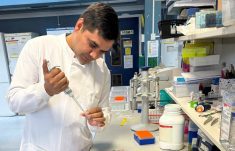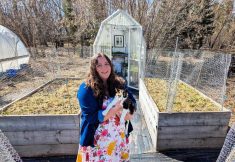WITH THE PROMISE OFbiotechnology comes the reality that Canada’s farmers have to wait and hope that the huge multinationals consider the market here large enough to be worth their while, and they’ll put their genes in crops that we can grow.
For Peter Hannam, that wasn’t good enough.
In fact, Hannam sold the first Roundup Ready soybean seed in Ontario, and is credited with bringing the biotech trait north of the border five years before it would have made it otherwise.
Read Also

Are you ready for farm succession?
What motivates some farmers to make a succession plan while others don’t seem worried.
Those who work with him say it’s just par for the course.
Hannam is president of Woodrill Farms Ltd., a crop supply and elevator business and grain and seed farm near Guelph. In the ’80s he started First Line Seeds, the first Canadian company to breed early-maturing and genetically modified soybeans. His vision and strong belief in research helped propel soybeans to Ontario’s largest field crop, covering 2.35 million acres.
In the ’60s Hannam first saw soybeans in a test plot while at the University of Guelph. His professor said soybeans would never be grown outside of the southwestern corner of the province. The challenge was on.
After graduating, Hannam imported an early garden variety of soybeans from Europe as an experiment. He quickly learned to grow them in seven-inch rows and then he found a premium market for seeds, sending them back to Europe packaged for gardening. He also began a breeding program for short-day soybeans.
In 1982, Hannam led a group of 12 farmers to form First Line Seeds. Strategy sessions in the early ’90s led them to concentrate on their strength — soybeans. Instead of trying to compete with the large corn seed companies they decided to do new category marketing, the same strategy Ford used to become the leader in pickup trucks.
Aligning complementary businesses is Hannam’s core strength. Initially, First Line Seeds had a marketing and distribution agreement with Funk, which had a strong corn brand. That benefited both companies for five years, until Funk’s owner (Ciba) merged with Sandoz.
Doug Knight, now director of seed, marketing sales and operations for Viterra, was head of Funk during the strategic alliance with First Line. “Peter is a constant clear visionary, always looking ahead,” Knight says. “He has the ability to maintain the fine balance between risk and reward.”
Next Hannam brokered an alliance with Asgrow, a leading U.S. soybean breeder, developer, and distributor. “In 1993 I toured the U.S. and learned that the herbicide traits were the next big thing,” Hannam says. “I also saw the U.S. breeding companies had winter programs in South America.”
First Line Seeds sold the first Roundup Ready soybean varieties in Canada, and then in 1998, Monsanto bought a portion of First Line, obtaining full ownership in 2004.
Yet if Hannam gets points for research and innovation, his marks for leadership are equally high, if not higher. In fact, it’s his leadership capability that seems to get first mention whenever his name comes up.
Gary Lannin, account manager for Dekalb and former employee of First Line Seeds was part of the dynamic group of mostly younger people who worked for First Line under Hannam’s leadership. “He has the ability to empower, especially young people,” says Lannin. “He sets the direction and allows you to figure out how to get there, but helps you along the way.
“We joke that Peter is a natural diplomat,” says Lannin. “He gets his own way by making it everyone else’s idea.”
Hannam continues to influence and mentor. His son Rob has started a think-tank, public relations firm and Greg has taken over the day-to-day of the farm, custom work, seed and elevator operations. Woodrill Farms has 25 full-time employees and every summer hires a dozen students.
Hannam makes it clear that when he looks at his career, his mentorship work has definitely been a two-way street.
“These young people are the vim and vigour,” says Hannam. “They give use new approaches and ideas. Staying connected to them is important.”
At 36 years old, Hannam was president of the Ontario Federation of Agriculture. To be able to spend so much time away from the farm, he worked with two young high school graduates. He supplied the land and the know-how and they supplied the sweat equity. Today, they’re successful farmers.
Hannam also served on the executives of the Canadian Soybean Export Association and the Canadian Seed Trade Association. More recently, he’s been using his collaborative skills for the whole industry. He’s on the board of the Canadian Agri-Food Policy Institute and is a member of the OAC International Advisory Council.
“Peter has the big-picture approach but also looks at it from a farmer’s angle,” says Lannin. “It’s not about him being successful, but about the whole industry.”
A few years ago, Hannam’s understated ability to form alliances was put into bricks and mortar. He and a contractor built the Ontario Agri-Centre in Guelph near the provincial Ministry of Agriculture’s building and the university. This practical cost-saving solution brought 20 different farm groups and companies physically together and closer to researchers. Now, they can also share boardrooms and resources.
One of the organizations is the newly formed alliance of soybean, corn and wheat grower organizations called Grain Farmers of Ontario. “He has a knack for getting whole groups to go in the same direction,” says Lannin.
In the ’60s when Hannam applied to university, his dairy farming parents didn’t have enough money for tuition, but somehow a bursary found its way to him so he could go.
“Since then I’ve had an open approach to donation, particularly to agriculture and the University of Guelph,” says Hannam.
Since he sold First Line, Hannam has instigated many industry collaborations and soybean-use research at his alma mater. Notably, Hannam contributed $1 million to fund research on new soybean products for 10 years. Research, he believes, is changing the face of what we will be able to do with all crops.














